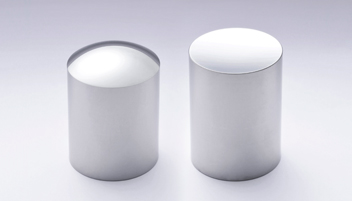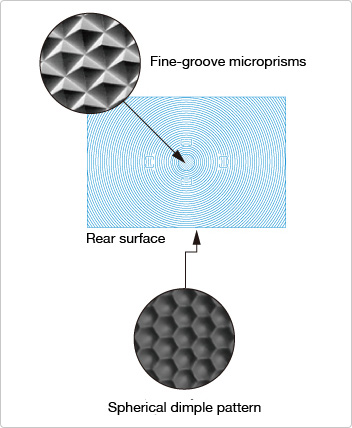Ultra-Precision Molds

Mold for injection molding of aspherical lenses
Resin flow analysis for penta mirror
3D image of penta mirror

Mold used to form camera viewfinder screens
There are many different types of precision molds. This article introduces precision molds used by Nikon for plastic optical components such as lenses, prisms and penta mirrors, which are accurate to the sub-micrometer* dimension.
Needless to say, molds for optical parts must be made for precision as designed, but in the molding process, dimensional stability against temperature change of the molded parts is extremely important.
For plastic optical components, melted optical resin is injected into a mold at high pressure. The resin is gradually cooled to the temperature of the mold, causing it to solidify. When the item is finally removed from the mold, it is cooled further to room temperature. Due to this drastic change of temperature, the volume of the molded item shrinks. But the shrinkage is not uniform, and the shrinkage ratio varies drastically, depending on shape, thickness, distance from the pouring gate and other factors.
Therefore, the structure of the mold is optimized by computer simulation to improve the overall precision.
With years of experience and expertise in this correction control technique, Nikon can carry out this design-prototyping process with very short lead time.
The diagram at left describes the formation process of an optical component called a "penta mirror" used for cameras.
The penta mirror is an optical component equivalent to a pentaprism, of considerably reduced weight achieved by replacing a glass prism block with a combination of several mirrors.
The internal surface of the hollow penta mirror is coated with a deposit of aluminum or silver as a front-surface mirror. A couple of flat mirrors inside the penta-mirror are precisely fabricated to be 90 degrees sharp, and no image distortion nor deflection is allowed around the area of intersection.
The optical surfaces in these optical components are not only flat or spherical, but may come in a variety of complex shapes. The matte viewfinder screen in a camera, for example, is not just a diffuser, but may also have dimple patterns to make the finder image brighter. These dimples are formed by pits in the formation mold using an original Nikon method.
- *One millionth of a meter.
Renewed April 2007
